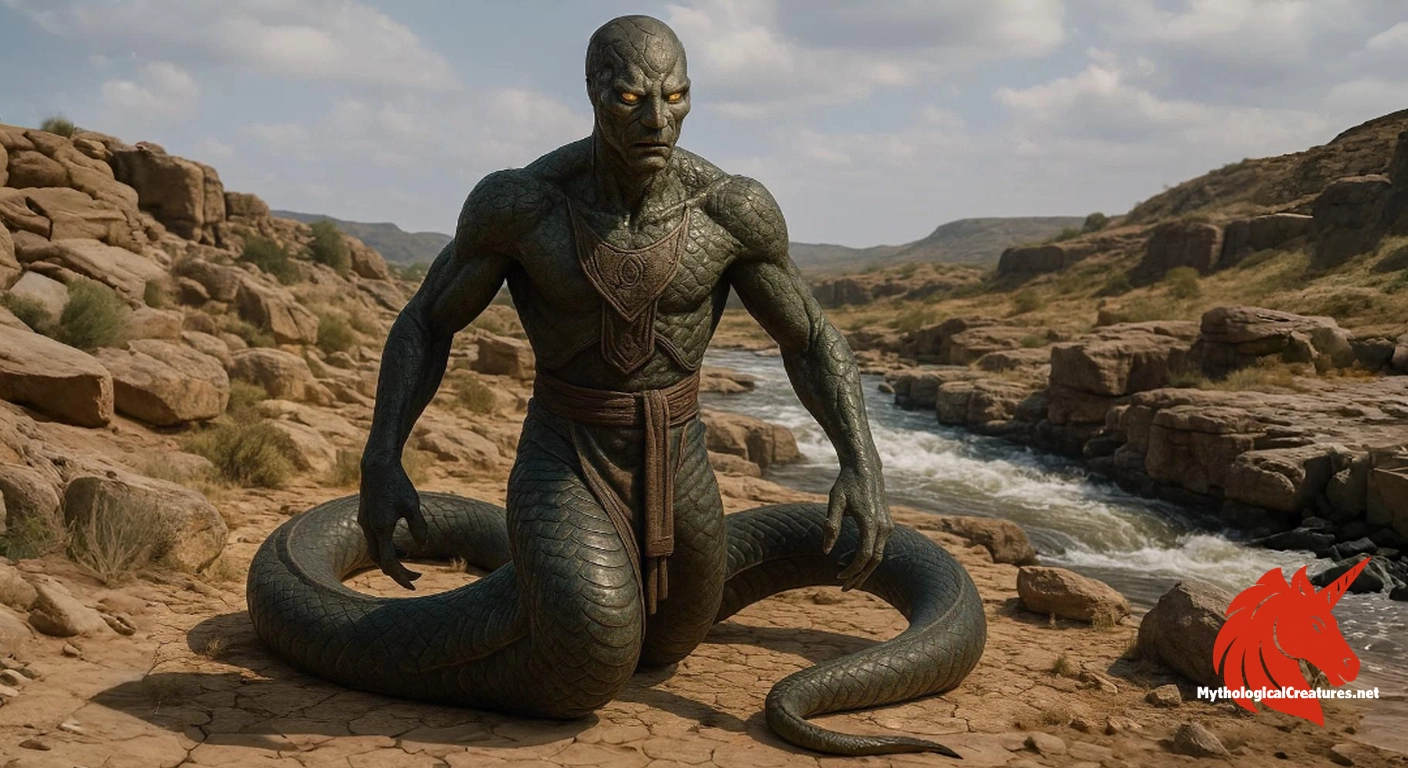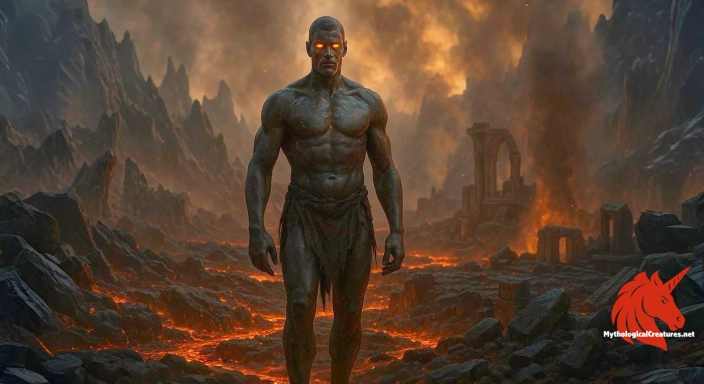Vritra: Vritra is a danava and the personification of drought in Hindu mythology, depicted as a giant, serpentine humanoid who obstructs river courses.

Vritra
Vritra - Represents the struggle between chaos (drought) and life (water) in Hindu mythology; his defeat marks the restoration of natural order.
Origins & First Encounters
Vritra stands as one of the most intriguing figures in early Hindu mythology, embodying the forces of drought and chaos in a rich tapestry of cosmic conflict. Emerging from the ancient Vedic tradition, his mythic presence is interwoven with the spiritual and natural narratives of early India. His first attestation appears in the Rigveda, establishing him as a formidable danava whose character challenges the dominion of divine order. Often referred to by the name Ahi, which signifies 'snake', his representation combines the fluidity of a serpent with the intensity of an adversary. His adversarial relationship with Indra, the king of the devas, symbolises the eternal struggle between primal elements and celestial order. The story of his opposition highlights themes of natural calamity and the cyclical patterns of drought and replenishment. His complex portrayal invites reflection on the balance between creative destruction and the restoration of life. Over time, Vritra’s myth has permeated cultural expressions, influencing religious thought, art, and literature. His enduring image resonates as a symbol of the inexorable clash between chaos and order.
Source Texts & Tale Variants
Ancient Vedic texts form the cornerstone of Vritra’s myth, with the Rigveda offering one of the earliest, vivid portrayals of this dread figure. Hymns within these scriptures introduce him as a dark and formidable force whose very presence disrupts the normal flow of nature. Known by the epithet Ahi, his depiction in these early texts leans heavily on serpentine imagery, reinforcing his association with drought and deprivation. Over time, additional layers of narrative were added by scriptures such as the Brahmanas and later Puranic literature, each contributing unique variants to his myth. These sources often recount his epic confrontation with Indra, emphasising dramatic elements that secure his place as a perennial adversary. The evolving corpus of texts has allowed the myth to be adapted and reinterpreted across centuries. Oral traditions have also played a significant role, with local storytellers enriching and sometimes altering the details to better suit cultural contexts. The multiplicity of sources not only underscores his importance in early Hindu thought but also reveals the dynamic process of myth-making in ancient India. Collectively, these varied records demonstrate how his story has been both preserved and transformed across time.
Form & Powers
Vritra is portrayed with a physicality that is as formidable as it is emblematic, merging human and serpentine characteristics into an entity of awe-inspiring presence. His elongated, coiled form is frequently depicted as massive and sinuous, evoking the relentless grip of drought and chaos over a barren landscape. The creature’s body is often adorned with shimmering scales that mirror the harsh, sun-scorched environments he dominates. His face, typically marked by fierce, penetrating eyes and a sinuous snout, hints at both a cunning intelligence and a primal ferocity. In some artistic renderings, hints of a humanoid structure are evident, with robust muscle and a commanding posture that emphasise his role as a celestial antagonist. The intricacy of his depiction varies across sources; while some accounts focus solely on his serpentine nature, others imbue him with additional anthropomorphic qualities. A powerful, whip-like tail is sometimes featured as a symbol of his restless energy and destructive potential. These detailed portrayals work in tandem to elevate his presence as a mythic force beyond simple physical description. Ultimately, the amalgamation of these visual elements crafts a creature that embodies the merging of the natural and the supernatural.
Regional Faces
The myth of Vritra has been adapted and reshaped as it travelled through different regions of South Asia, resulting in a spectrum of local interpretations. In several parts of India, he is not only seen as a harbinger of drought but also as a personification of nature’s unpredictable and untamable forces. Some communities have embraced his image as a symbol of the struggle against natural adversity, integrating his tale into regional festivals and ritual celebrations. In northern areas, variations of his legend even imbue him with traits reminiscent of a mighty dragon, thereby reinforcing his association with both water and its absence. Local narratives often highlight the duality of his nature, portraying him as both destructive and a catalyst for rejuvenation following the retreat of drought. The oral traditions of these regions have allowed his myth to absorb unique cultural flavours, adapting his role to resonate with local environmental challenges. Artistic depictions in temple carvings and regional paintings further illustrate these nuances, blending indigenous aesthetics with ancient symbolism. Consequently, his portrayal is as diverse as the communities that revere or recount his myth. Overall, these regional variations enrich the legacy of Vritra and underscore the versatility of myth in reflecting local realities.
Cultural Parallels
Comparative analysis reveals striking parallels between the myth of Vritra and other serpentine or draconic figures found in diverse cultural traditions. His legendary battle with Indra echoes the universal narrative of a storm or sun deity combatting a formidable chaos monster. Similar themes emerge in the stories of the Babylonian Tiamat and the Norse Jörmungandr, both of which symbolise primordial forces of disorder. These cross-cultural comparisons emphasise a shared allegorical motif, wherein the triumph of a divine figure over a chaotic serpent represents the re-establishment of cosmic order. The physical and symbolic characteristics of Vritra—his sinuous form, his association with drought, and his ultimate defeat—resonate with the broader archetype of chaos, which many ancient societies constructed to explain natural phenomena. His myth, much like those of comparable creatures, underscores humanity’s early attempts to reconcile the unpredictable facets of nature with an emerging sense of order and civilisation. The recurring theme of a deity overcoming darkness reflects deep-seated cultural narratives that seek to explain seasonal and environmental cycles. Such comparative reflections not only deepen our understanding of Vritra’s myth but also highlight the interconnectedness of human myth-making across geographical divides. In essence, his story reinforces an enduring archetype that transcends time and culture.
Legacy & Modern Evolution
The myth of Vritra has undergone a remarkable evolution, reflecting shifts in religious sentiment, artistic style, and sociocultural values over the centuries. Initially depicted in the Rigveda as a menacing symbol of drought, his portrayal later expanded to encompass a more complex allegory of the eternal struggle between chaos and order. As his narrative was retold and recontextualised through Puranic literature and regional folklore, Vritra's image adapted to express local concerns about the environment and cosmic balance. His defeat by Indra emerged as a powerful metaphor for the cyclical nature of adversity and renewal, a theme that continues to resonate in the modern era. In recent times, his image has found new life in contemporary literature, visual arts, and even cinematic adaptations, where he is often portrayed as a timeless embodiment of natural and existential challenges. This modern reimagining underscores the enduring appeal of mythic archetypes and their capacity to reflect current issues such as climate volatility and environmental degradation. Artists and writers alike draw on his storied past to evoke a sense of both awe and caution in the face of nature’s forces. Furthermore, academic and popular explorations of his myth have opened new avenues for interpreting ancient narratives in the light of modern scientific and ecological perspectives. Ultimately, the legacy of Vritra stands as a testament to the perpetual dialogue between humanity and the mysterious, often unpredictable, rhythms of the natural world.
Interesting Fact
Vritra's alternate name 'Ahi' translates to 'snake', a reminder of his serpentine nature, and his role in myth highlights the ancient human fascination with the cycles of drought and abundance.
Quick Creature Info
Features:
Associations:
Our Mythic Legendary Rating:

Also Sometimes Known As:
Habitat:
Supernatural Powers:
Physical Attributes:
Abilities:
Behavior:
Weaknesses:
Lore:
Related Creatures, Tales or Lore
- AApophis (Egyptian)
- JJörmungandr (Norse)
- TTyphon (Greek)
References
Discover Another Mythical Legend You May Not Have Heard Of?
Uncover the mysteries of ancient folklore and expand your knowledge of legendary beings from cultures around the world.
Dare to Meet the Belial....
Mythical Disclaimer: The images and data on this site are derived from various historical and literary sources, but we have found that many myths often have multiple versions and interpretations across references, sometimes contradictory. As a result, these creature depictions are artistic interpretations—imaginative blends of folklore, legend, and a dash of AI guesswork. Because creature descriptions vary widely, our illustrations and accompanying information represent our best effort to honor mythology while bridging creative gaps. Enjoy these interpretations—just remember, we've done our best to respect the stories and validate available data, but in the realm of mythology, details often shift, imagination leads the way, and nothing is ever set in stone!
Curated by the Mythological Creatures Team (rev. May 2025)
